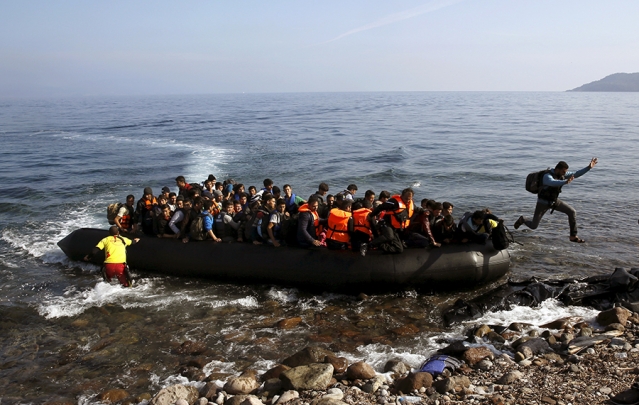The Worst of the Syrian Refugee Crisis Is Coming for Europe
Fabrice Balanche/Washington Institute/February 13/16
The Assad regime’s Russian-aided military campaign and the onset of spring augur another mass refugee flow into the EU, and the only surefire way to stop it is by addressing the root of the crisis inside Syria.
The recent offensive by regime and allied forces around Aleppo is pushing tens of thousands of new Syrian refugees into Turkey. Some of them have fled their homes for the first time, while others left informal camps close to the northern border before the fighting could reach them. For most of these refugees, Turkey is only a transit country to Europe. They have lost hope for a quick end to the conflict, and those who supported the rebellion know it would be particularly difficult to return. The European Union can therefore expect a massive new influx of Syrians in the coming months, despite Ankara’s promises to keep them in Turkey.
BIG INCREASE IN TURKEY
As of this month, the Office of the UN High Commissioner for Refugees (UNHCR) has registered 4.6 million Syrians in neighboring countries, against 3.3 million in January 2015. Even this considerable number underestimates the problem because not all Syrians formally apply for refugee status. In Jordan, for example, the government’s Department of Statistics counted 1,250,000 Syrians in a recent census, nearly double the 623,000 officially registered by UNHCR (see “Jordan Reaches the Refugee Saturation Point”).
More important, UNHCR figures indicate that the vast bulk of the increased flow since 2015 is being shouldered by Turkey. The number of registered refugees actually declined in Lebanon (1,070,000 last month, down from 1,146,000 in January 2015), Jordan (623,000, down from 633,000), and Egypt (123,500, down from 138,000), while increasing a little in Iraq (245,000 against 234,000). These people did not return to Syria, however — they traveled to Europe via Turkey by road, plane, or boat. As a result, Ankara’s claimed number of refugees increased from 1.5 million in January 2015 to 2.5 million last month.
To be sure, Turkey has likely exaggerated this number somewhat in order to get more help from the EU. But other official statistics understate the increase, since many of the refugees who registered in Middle Eastern countries have moved on to Europe so quickly that their original host governments have not yet removed them from their rolls.
The main cause of this accelerated flow is the Russian intervention. In spring 2015, some Syrian refugees had actually begun to return to Idlib after rebel offensives led regime forces to pull out. Yet these same refugees are now fleeing the country once again — massive bombardments have driven at least 300,000 from their homes in the past four months alone.
Today, most of the refugees in Turkey do not want to stay there. For four years, they patiently remained in southern provinces near the border hoping to return home quickly when conditions permitted it, but the Russian-powered offensive has spurred many to abandon that hope and head for more hospitable countries in Europe (see “Why Now? The Syrian Refugee Flow to Europe,” PolicyWatch 2515). Other Syrians have left relatively safe regime-controlled zones back home for economic reasons, heading straight to Europe.
On January 1, Turkey reversed its visa-free entry policy for Syrians, effectively cutting off several legal avenues for refugees to cross the border (e.g., via plane from Beirut or via shipping lines between Tripoli and Mersin). Yet illegal passage remains a readily available option, whether by land or on cargo vessels. And plenty of these boats will no doubt attempt to carry refugees directly to European coasts.
ANOTHER MASS FLOW TO EUROPE THIS SPRING
Last year, 1.5 million illegal immigrants reached the EU by various routes. More than 850,000 crossed the sea between Turkey and Greece, and another 150,000 arrived in Italy from the Libyan coast. Syrians constituted one-third of these immigrants — as of December, the total number of Syrian asylum applicants in the EU was 897,000, up from 235,000 in only a year’s time. Much of this increase began last spring, peaking at 156,000 in October.
Although the Russian intervention is responsible for the sheer size of the latest spike, the numbers also show a seasonal pattern. From June to November 2014, over 10,000 asylum requests were made per month; that average decreased by half in the winter months, then increased in spring 2015 as better weather and calmer seas facilitated passage. The number dropped by half again last November due to weather conditions and more stringent control measures by Turkish authorities. But when spring returns, it should regain its stride — likely helped along by a large regime offensive in northwestern Syria.
While the migratory flow to Europe is linked to deteriorating conditions for refugees in Middle Eastern countries, the evolution of the crisis inside Syria is becoming an ever-greater factor. Continued fighting is further damaging the economic situation even in peaceful areas of the country, pushing more Syrians to leave — particularly those in the private sector, who do not have the guaranteed salaries of state employees. But the largest group of refugees will be those fleeing new offensives, particularly where aerial bombardment is heaviest. This is why some Russian airstrikes have deliberately destroyed hospitals and other infrastructure — as a means of urging civilians to flee and thus isolating the rebels. The Syrian army cannot attempt to retake an area if noncombatants are present en masse; such operations would cause heavy civilian losses that could exacerbate international condemnation and further alienate the population. An effective counterinsurgency policy therefore requires encircling such areas and waiting for civilians to leave (see PolicyWatch 2554, “The Battle of Aleppo Is the Center of the Syrian Chessboard”).
ONE MILLION REFUGEES TO THE EU IN 2016?
Over the coming year, more than two million people could be displaced by fighting in northwestern Syria — specifically the rebel-held portions of Idlib province and western Aleppo province, and the Islamic State’s territories in eastern Aleppo province. The drastic increase in Turkey’s refugee numbers since September is a major indicator of where many of these refugees will head. Therefore, unless a major geopolitical shift changes the prevailing situation inside Syria, Europe has to prepare itself to welcome as many as a million new refugees in 2016. This estimate is extrapolated from several factors: the location of the populations most under threat from new regime offensives, their most likely routes of escape, the past migration patterns seen under similar conditions, and the recent trend of refugees leaving Turkey for the EU.
Part of the reason for this increase is that refugees who have already made it to Europe tend to serve as bridgeheads for others still in Syria or neighboring countries, providing information and money to family members and friends seeking to join them. Many are also able to exercise family reunification rights that could provide visas to hundreds of thousands of people.
Short of addressing the roots of the problem in Syria, the EU is largely helpless to stop this mass migration once it is under way. Some European countries are taking unilateral actions — for example, Serbia, Hungary, and Slovenia have erected barriers on their borders. Yet these measures are ineffective at the moment (e.g., refugees can bypass the barriers by going through the Czech Republic and Poland), and they risk shattering the Schengen Area.
Massively increasing refugee-related funding to Syria’s neighbors will not halt the flow to Europe either. The EU’s welfare system is too strong a magnet for poor migrants, as is the promise of safety and, perhaps, a passport.
EUROPE’S PARADOXICAL POLICY
Interestingly, European countries have authorized very few Syrian immigration requests from foreign consulates, yet have legalized almost all refugees who managed to reach their shores through other means. In doing so, Europe is actually encouraging illegal immigration. If refugees who arrived by such means had no chance of being legalized, they would be less likely to attempt the journey. The EU should therefore consider reserving residency permits for those who apply from neighboring countries.
Unofficially, the subsidies that the EU grants to adjacent nonmember states under the European Neighborhood Policy are conditioned on effective border control and a commitment to take back illegal immigrants. This may explain why the Syrian refugee flow across the Strait of Gibraltar is so low (around 5,000 in 2015) — unlike Turkey, whose EU accession process has been roiled by controversy for years, Morocco is more dependent on European trade and therefore quite serious about its various legal obligations to the union.
In the end, the best way to prevent mass refugee flows into Europe is to address the roots of the problem in Syria, assuming it is not already too late. Turkey is refusing new refugees even if they are in an awful situation on the other side of the border, partly to avoid helping the Russian counterinsurgency strategy. Western countries could adopt a similar policy, but only if they are willing to alleviate the resultant humanitarian crisis. Such considerations bring the idea of implementing a safe haven to protect civilians in northern and southern Syria back to the forefront of the debate.
**Fabrice Balanche, an associate professor and research director at the University of Lyon 2, is a visiting fellow at The Washington Institute.






















